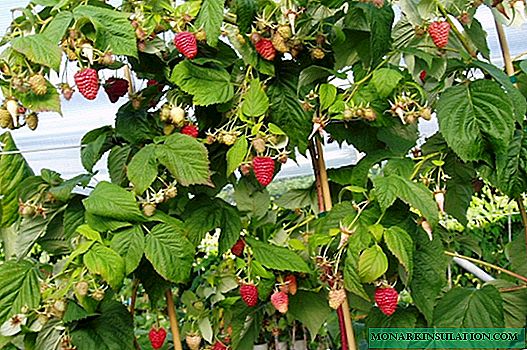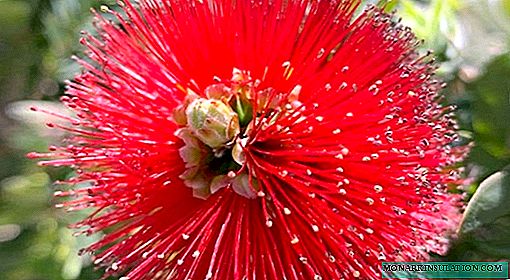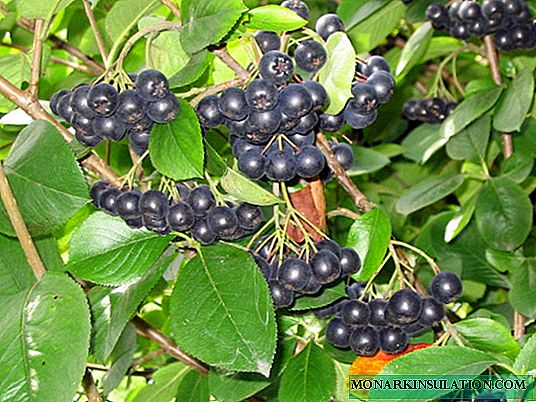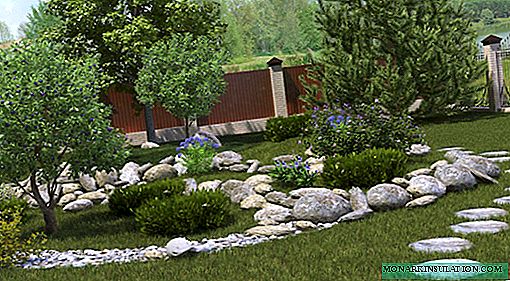
You can achieve spectacular landscaping of the land by carefully planning the landscape. Plants must be placed beautifully on the landscaped area, adhering to a certain order so that they do not interfere with each other's growth. The purchase of planting material is carried out taking into account the existing plantings. During the construction of new facilities, they try to preserve to the maximum adult trees and shrubs, the location of which is applied by specialists on the dendroplan (topographic map) in the form of generally accepted signs. Single plants, as well as groups of homogeneous plantings, are assigned a separate number, which is indicated on the plan, and is entered in the list of accounts. In this document, the name of each plant is indicated, and all its properties and characteristics are described in detail. From the counting sheet, specialists will learn about the height and steminess of the plant, the presence of damage, dry branches, and a hollow. This information allows you to evaluate each plant and express it in offsetting value. Next, the question of cutting down plantations that impede construction is being decided, and planting of new representatives of the plant world is planned.
What determines the need for a dendroplane?
Deforestation, as well as transplantation of green spaces that fall into the zone of development or construction of utilities, is possible only with the permission of the state bodies responsible for regulating issues in the field of nature management. Therefore, when designing construction works, along with other types of surveys on the built-up territory, dendrological studies are also carried out, as a result of which the dendroplan of the site appears. This document, together with the counting sheet, is submitted to the controlling state bodies, which provide an opinion and a felling ticket, which allows cutting down the green spaces or replanting them.

Cutting down trees on a garden plot is carried out with the permission of the authorities that control the implementation of environmental regulations by the citizens of the country, based on the dendroplane and the transfer statement
For all plants destroyed and damaged during construction work, the developer must pay in full their compensation value. In addition, the company carries out work on landscaping, which are designed to compensate for damage and environmental damage.
Landscaping and gardening of a garden plot cannot be carried out without specialists compiling a competent dendroplan. The planting plan is developed on a computer in special programs, and the established standard distances between the plant axes and the existing structure are necessarily observed. The intervals allowed between adjacent sections of green spaces are also observed without fail.

The tree topographic survey of trees on the garden plot is carried out by specialists who evaluate the tree plantations and enter their location on the dendroplan
Timely drawn up dendroplan allows you to avoid mistakes during landscaping and avoid unnecessary expenses. The implementation of the planned measures to improve the territory is also accelerating, since the work is being carried out clearly in accordance with the dendroplan of the garden plot.
Topographic scale and conventions
The scale of the dendroplane 1: 500 means that five meters of the plot on the map are depicted as a centimeter section. When developing landscape design projects, drawings made on a larger scale (1: 100 or 1: 200) can be used. This allows you to display each tree and indicate its species, height, and diameter of the trunk.

The dendroplan of the garden plot, made by specialists on a scale of 1: 100, with a detailed explication, which indicates the names of the plants used in the decoration of the territory
For application to the dendroplane, performed on a scale of 1: 500, of wood and shrubbery, special symbols are used - circles, the diameter of which is 3 mm. If the drawing is heavily loaded, then the diameter of the circles is reduced to 2 mm. Observing the rules for compiling a dendroplane, highlight with a color or an additional circle of a larger diameter especially valuable trees, coniferous, historical and relict.
- If the circle is not painted over on the dendroplane, then this tree must be preserved.
- If the circle is half full, then the large-sized tree will need to be transplanted.
- If the circle is painted over completely, then this tree is subject to cutting down.
Multi-stemmed trees, like single-stemmed trees, are denoted on the dendrological plan of the garden plot as one circle. Groups of shrubs and trees can be represented on the plan in the form of separate circles or in the form of an oval, occupying on the map, taking into account the scale, as much space as on the site. When performing a tree-shooting, self-seeding and shoots are denoted by a contour, like a bush, not forgetting to assign a serial number.
Important! When transferring to the topoplan the existing plants in the form of circles, an error equal to one millimeter in the scale of the drawing is allowed. On the ground, this is equivalent to half a meter.
Below are a few examples of the dendroplan of garden plots, which are schematically located construction projects and green spaces listed in the explication.

The dendroplan of the suburban area, which is marked with numbers in red circles of the building, and the stands listed in the explication are numbered in black circles

An example of a dendroplane of another suburban area, during the creation of which other symbols were used. In particular, the buildings are numbered with Roman numbers.
Remember that spruce, fir and yew prefer to grow in the shade, with a sufficient level of humidity and even thermal conditions, devoid of sudden changes in temperature values. When planting barberry and cotoneaster, it should be borne in mind that these shrubs require a lot of sunlight. Vapors of moisture and constant temperature changes have a beneficial effect on the well-being of these plants.
What factors are considered during development?
From the creativity and responsibility of landscape designers involved in the development of the dendroplane, the beauty of the design of the territory depends. Moreover, over time, the appearance of the site should improve. To do this, plantings should be planted in conditions favorable for their further growth and healthy development. The planting plan is made taking into account the size of the crowns of adult trees, flowering periods and other conditions. When developing a dendroplane and planning future plantings, specialists take into account a number of factors.
- Features of soil and climatic conditions in the region. The selection of plants is made taking into account these conditions, otherwise it is unlikely to achieve a flowering appearance of all plantings. Attention is drawn to the need of plants for moisture, light, heat. The actual topography of the land also matters.
- Compatibility Plants selected for planting should be appropriate to the environment, as well as the age and architecture of buildings that were once built or re-built in the area. With the help of plant varieties and the method of their location, you can shade the contours of individual objects located on the site. It is possible to achieve harmony and natural naturalness due to the special organization of space carried out with the help of structural and accent plants.
- Compatibility. To ignore this factor with all the desire, it will not work, since compatibility rules apply in the plant world. Subject to compliance, their adjacent copies perfectly complement each other. For example, spruce perfectly adjoins mountain ash, birch or hazel. The pine neighbor can be oak or juniper. Larch coexists with fir and rose hips.
- Availability. When planting plants provide freedom of access to them for subsequent care. You can not allow crowding of plantings, trying to plant as many varieties and species of plants as possible on the site. With this approach, it is impossible to ensure a decent appearance of the landscaped area.
- Seasonality To give the site a flowering appearance at different periods of the year, pay attention to the timing of flowering of planted plants. Some styles of landscape design suggest a certain color scheme in the design of the garden plot. Choosing unpretentious plants, you can minimize the maintenance of the garden, without compromising the attractiveness of the site. One of these plants is the wild rose, which adorns the territory for a long time due to its long flowering.
- The cost of landscaping. The project budget, calculated using the assortment list, depends on the financial capabilities of the customer. Therefore, the amount of financing also has to be taken into account when landscaping and landscaping the land.
It is better to deal with the preparation of the dendroplan of the territory and filling out the transfer statement on a computer. When using ready-made software, specialists are able to quickly combine the actual site plan with the landing plan. By modeling, you can predict the landscape of the territory after a given period of time and see the plantings at the peak of their heyday.
Rules for the preparation of the assortment list
When planning plantings on a garden plot, an assortment list is applied to the dendroplane, listing all the plants purchased. This document allows you to draw up a project budget, justifying all items of expenses for the purchase of the necessary planting material. When filling out the assortment list, plants are arranged in groups in a certain sequence. At the beginning of the list indicate conifers and shrubs. Then comes the turn of fruit trees and shrubs. After they make all the deciduous plants, and after them - the vines.
The assortment list must necessarily indicate the full name of the plant, including in Latin, and the required number of planting specimens. In addition, the characteristics of plants, such as height, crown projection, decorative features, a variety of root system, etc., are reflected in the assortment list.

Preservation of woody and shrubby vegetation during the construction of facilities is possible with a competent study of the site and the preparation of a dendroplane with a counting sheet
In conclusion, we can say that the dendroplan, developed by professionals taking into account the requirements for this type of document, allows you to optimally arrange objects under construction, while preserving the trees and shrubs growing on the site. This will affect the reduction in financial costs required when organizing the cutting of plants and the subsequent work on compensatory landscaping. Tailoring provides a rational approach to landscaping, which maintains healthy woody vegetation in its virgin form. This increases the attractiveness of the site and reduces (or completely eliminates) the purchase, delivery and landing of large crops.











